What Brigham Young Said: Opinions or Truths?
Brigham Young is known as many things: a carpenter, a polygamist, a pioneer, and a prophet. Members of The Church of Jesus Christ of Latter-day Saints know he was our second modern-day prophet, one who lead the saints to the Utah Territory, which he helped establish and govern. There is no doubt that Brigham Young was a great man; however, a few statements of his may cause some to doubt not only Brigham, but our church as well. Critics may use these controversial quotes as evidence that Brigham Young and the Church are false. However, in this article, we take a close look at these quotes and explore the reasons why Brigham Young may have said these things.
Many of Brigham Young’s controversial statements are actually taken from a publication called The Journal of Discourses which is not endorsed by the Church because it is an inaccurate and unreliable source. We must also keep in mind the context and time period Brigham was speaking in, that the quote may have been his personal opinion, and how he could have preached using metaphors and other rhetorical devices. Finally, we must always remember that even though our prophets are called of God, they are human and make mistakes. The prophets are not infallible, but the gospel is.
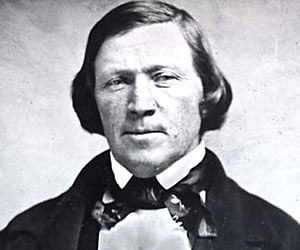
Journal of Discourses
Before delving into some of the issues with Brigham Young’s quotes, it is important to note that all of these statements are found in a publication called the Journal of Discourses. This publication was printed in Liverpool, England, between 1854 and 1886 for those who did not have access to Utah church publications. And “While the Journal most often published sermons of Church leaders, these speeches were not always considered to be official statements of doctrine. Many different kinds of speeches were printed” (Encyclopedia of Mormonism “Journal of Discourses).
The Church, in LDS.org’s article “Journal of Discourses,” also states that the content in the Journal of Discourses is not necessarily doctrine because the Journal is not an official publication of the Church. There is also the fact that some of the transcriptions are unreliable and “speculative in nature.” This article further declares:
Modern technology and processes were not available for verifying the accuracy of transcriptions, and some significant mistakes have been documented. The Journal of Discourses includes interesting and insightful teachings by early Church leaders; however, by itself it is not an authoritative source of Church doctrine.
Because the content from the Journal of Discourses may not be accurate, we should take quotes from it with a grain of salt. The transcription may be flawed, or have left out details crucial to understanding the content and context of what was being said.
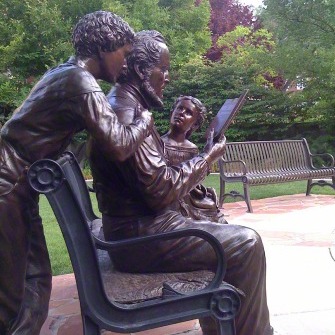
Context of a Quote
Often, we forget to look at the context a quote is spoken in. When taken out of context, some of Brigham’s statements seem confusing or controversial. But when we take a look at the surrounding text or historical setting of a quote, it can help us better understand what he may have meant.
For example, there is a Brigham Young quote in which he seems to teach that people lived on the moon. This statement from the Journal of Discourses section 271 reads:
Who can tell us of the inhabitants of this little planet that shines of an evening, called the moon? When we view its face we may see what is termed “the man in the moon,” and what some philosophers declare are the shadows of mountains. But these sayings are very vague, and amount to nothing; and when you inquire about the inhabitants of that sphere you find that the most learned are as ignorant in regard to them as the most ignorant of their fellows.
Critics may use this statement as evidence that Brigham Young was a false prophet since there are no people living on the moon. But when we take note of the context of Brigham Young’s statement, we see that that is not the case. Just before he made this quote, he spoke of how others view our religion as fanatical. But he points out that there is no means by which they can prove our religion wrong. “Are not all ignorant?” he asks, and then uses the idea of people living on the moon as an example of ignorance.
So in reality, Brigham was not preaching that people were living on the moon, but notes that we do not know whether there could be. Since the technology at this time was not advanced enough to determine whether or whether not life existed on the moon, it was always a possibility. The fact that people did not know whether the moon was inhabited or not was a metaphor for how others could not prove the Church false. That is the context the quote was spoken in.

Violence in 19th Century Rhetoric
The rhetorical style often used in the 19th century was much more blunt and violent than what we are used to today. When we read speeches from this time, we may be shocked by the statements said with the use of this aggressive style of rhetoric. Brigham Young is no exception to the rule, and a good example of his strong rhetoric would be with the concept of blood atonement.
What is blood atonement? Supposedly it was a principle taught by Brigham Young saying that those who have sinned (and in more specific instances, apostatized) cannot have their mistakes made clean through the atonement of Christ, so they must give up their own lives in order to be saved. However, this concept would appear to have evolved from voluntary death, to allowing others to “save” the sinners by killing them.
The Fair Mormon article “Utah/Crime and violence” quotes the Journal of Discourses where Brigham says that if you put a javelin through the hearts of adulterers, “you would be justified, and they would atone for their sins, and be received into the kingdom of God.”
So what might have Brigham meant by blood atonement? Many who have explored the subject agree that blood atonement was not meant to be preached as doctrine, but rather used as a rhetorical tool. In the “Blood Atonement” entry in the Encyclopedia of Mormonism, it states that “the practical effect of the idea was its use as a rhetorical device to heighten the awareness of Latter-day Saints of the seriousness of murder and other major sins.”
There is also no evidence that Brigham Young caused anyone to undergo blood atonement. In fact, this idea became so popularized by the general public in America that every violent act which occurred in Utah, whether perpetrated by members or not, was associated with blood atonement. Additionally, the phrasing of another quote from the Journal of Discourses on blood atonement would seem to support the idea of blood atonement’s use as a rhetorical tool.
In this quote, Brigham asks “will you fellowship?” This indicates a question of potential willingness rather than of actual action.
The Church in Deseret News article, “Mormon church statement on blood atonement,” also supports the idea of blood atonement as an aggressive speech metaphor when they say:
In the mid-19th century, when rhetorical, emotional oratory was common, some church members and leaders used strong language that included notions of people making restitution for their sins by giving up their own lives.
Fair Mormon’s “What is blood atonement?” article notes that Brigham himself said, in regards to his aggressive preaching style, “I will tell you what this people need, with regard to preaching. You need, figuratively, to have it rain pitchforks, tines downwards. . . . Instead of the smooth, beautiful, sweet, still, silk-velvet-lipped preaching, you should have sermons like peals of thunder.”
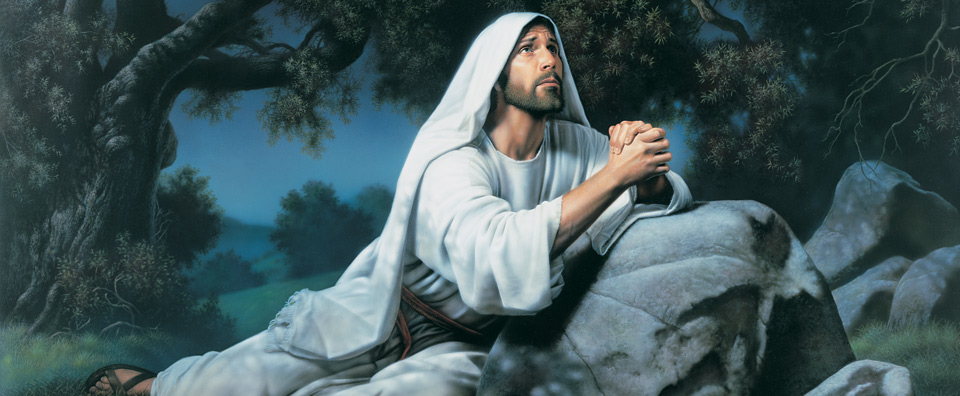
Brigham’s Opinions and Theories
Not all of Brigham’s statements were official doctrines of the Church. Some of his statements may simply have been opinions or theories of his. One such example deals with his statement of people living on the moon. Earlier, I explained that confusion over this quote is over context, however, the quote continues further to include people living on the sun:
So it is with regard to the inhabitants of the sun. Do you think it is inhabited? I rather think it is. Do you think there is any life there? No question of it; it was not made in vain. It was made to give light to those who dwell upon it, and to other planets; and so will this earth when it is celestialized.
This statement could also be seen as part of context of the metaphor on human ignorance. However, it seems more direct than the moon statement is, especially when Brigham says that there is “No question” in regards to there being life on the sun. What did he mean by that?
Brigham may have been speaking of symbols, or more specifically how the celestial and terrestrial worlds are compared to the light of the sun and moon in the scriptures (see 1 Corinthians 15:40-42 and D&C, Section 76). The Fair Mormon article “Brigham Young taught that the moon and sun were inhabited” suggests the idea of Brigham expressing an opinion rather than preaching doctrine. This is supported by the fact that in query to whether the sun is inhabited, instead of stating, “it is,” he says, “I rather think it is” (emphasis added).
Joseph Smith taught that God dwells in eternal fire. As found in the Doctrine and Covenants, Section 37:
I saw the transcendent beauty of the gate through which the heirs of that kingdom will enter, which was like unto circling flames of fire;
Also the blazing throne of God, whereon was seated the Father and the Son.
At that time no one knew that stars were suns. Eternal fire, then, would logically be the Sun.

The Adam-God Theory
Another instance of Brigham’s opinion was with the “Adam-God Theory.” The Adam-God theory is a concept that Brigham spoke of often. This is the idea that Adam, the first man, and God, our father in heaven, were actually the same person both spiritually and physically. This doctrine, of course, causes confusion because it is contrary to what we learn in the standard works. In the Journal of Discourses section 50, there is a quote from Brigham Young on this concept, which essentially surmised that Adam and Eve came from a celestial world and became mortal when they partook of the forbidden fruit.
Because this idea goes against the teachings of the standard works, it is actually a bit of a mystery and it is difficult to explain why Brigham developed this theory. Fair Mormon’s article, “What is the Adam-God Theory?”, quotes BYU professor Stephen E. Robinson who called the Adam-God theory an “anomaly . . . something unexpected that cannot be explained by the existing laws or theories, but which does not constitute evidence for changing the laws and theories.”
Of course, it is not surprising that there are some things that cannot be explained in the history of our religion, especially for something that is a theory. But what might have Brigham meant by this concept? Maybe he meant that Adam would become a god someday after his resurrection. Or perhaps he was referring to how Adam helped create the earth with God and Christ as the archangel Michael.
Another explanation for the Adam-God theory deals with the use of the name “Adam” as a title. In Jeff Lindays’ LDS FAQ:Mormon Answers “Do Mormons worship Adam?”, he suggests that Brigham’s theory may be referring to the name “Adam” as the title of “first father.” This term would be applicable to God, the father of our spirits, and Adam, the father of our physical bodies. He uses a few scriptures to support this idea, including 1 Corinthians 15:45-47 which reads:
And so it is written, The first man Adam was made a living soul; the last Adam was made a quickening spirit.
Howbeit that was not first which is spiritual, but that which is natural; and afterward that which is spiritual.
The first man is of the earth, earthy: the second man is the Lord from heaven.
Since these scriptures speak of two different Adams, they support the explanation that Brigham Young’s Adam-God theory may have been in reference to the title of “Adam.”

Incorporating Teachings As Official Doctrine
Another important thing to remember is whether these controversial quotes or teachings were stated in an official church capacity, sustained by the leaders of the Church, and taught frequently by them. Often, the material found in publications like the Journal of Discourses was not always from official Church capacities and therefore was not established as official doctrine of the Church.
Such is the case with the Adam-God theory. The article “The Development of the Mormon Understanding of God” references a letter written by Wilfred Woodruff and Joseph F. Smith in which they speak of it:
President Young no doubt expressed his personal opinion or views upon the subject. What he said was not given as revelation or commandment from the Lord. The doctrine was never submitted to the councils of the Priesthood nor to the Church for approval or ratification, and was never formally or otherwise accepted by the Church. It is therefore in no sense binding upon the Church.
Another indicator that this theory, and the concept of blood atonement, are not doctrines of the Church is that they are not found in the standard works. We know from the scriptures that God and Adam are separate beings, physically and spiritually. We also learn that “thou shalt not kill” is one of the ten commandments (Exodus 20:13) and that Christ’s atonement can compensate for all sins.
Though we may still have unanswered questions about concepts like the Adam-God theory, they should not be our religious focus, since the theory is not doctrine for our gospel. As Robinson says of the Adam-God theory, “the point is moot, since whatever Brigham Young said, true or false, was never presented to the Church for a sustaining vote. It was not then and is not now a doctrine of the Church.”
The Church has spoken of official doctrine before. Mormon Newsroom article “Approaching Mormon Doctrine” states:
Not every statement made by a Church leader, past or present, necessarily constitutes doctrine. A single statement made by a single leader on a single occasion often represents a personal, though well-considered, opinion, but is not meant to be officially binding for the whole Church.
This article further notes that the doctrine of our Church is taught by all fifteen of the prophets and apostles, is found in the standard works, and is preached often.
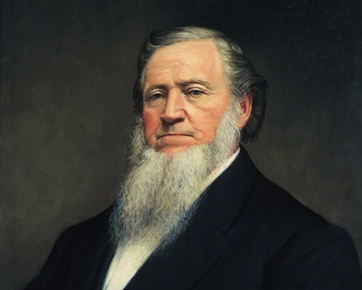
Modern Church Leaders Denouncing Brigham’s Statements
It is always important to remember that our church has modern-day revelation and modern-day prophets. This means that we receive counsel and commands from God in this day through our prophets and apostles. This is why we attend church every Sunday and watch conference twice a year, because we are continually receiving revelation, learning from it, and following through on it.
One of the important aspects of modern-day revelation is that it can refute misconceived concepts taught in the past. The Adam-God Theory is one such example. It is not a doctrine of our Church and was denounced by Spencer W. Kimball in his October 1976 General Conference talk “Our Own Liahona.” He also warned members:
…against the dissemination of doctrines which are not according to the scriptures and which are alleged to have been taught by some of the General Authorities of past generations.
Some may believe that when current prophets and apostles denounce the statements of previous church leaders that it is just an attempt for our Church not to take responsibility for what they said. This is not true. In this case, it is a clarification of doctrine over some confusing statements which—if Brigham Young really did say them—were probably just his opinion.
Clarification is one reason for why modern-day prophets could refute statements from previous church leaders. Another is the historical setting and cultural differences of the past.
One of the key things to remember (and one of the key differences between our church and others) is that we have modern-day revelation and prophets. In his Religious Educators Symposium address “All Are Alike unto God,” Elder Bruce R. McConkie says:
…it is time disbelieving people repented and got in line and believed in a living, modern prophet. Forget everything that I have said, or what President Brigham Young or President George Q. Cannon or whomsoever has said in days past that is contrary to the present revelation. We spoke with a limited understanding and without the light and knowledge that now has come into the world.
God teaches us line upon line through His prophets. He seems willing to tolerate our clumsy use of what light we have been given, the way we tolerate and even appreciate the clumsy attempts of toddlers and small children to understand mature concepts. He knows, as we know as loving parents, that the immature will eventually “get it.”
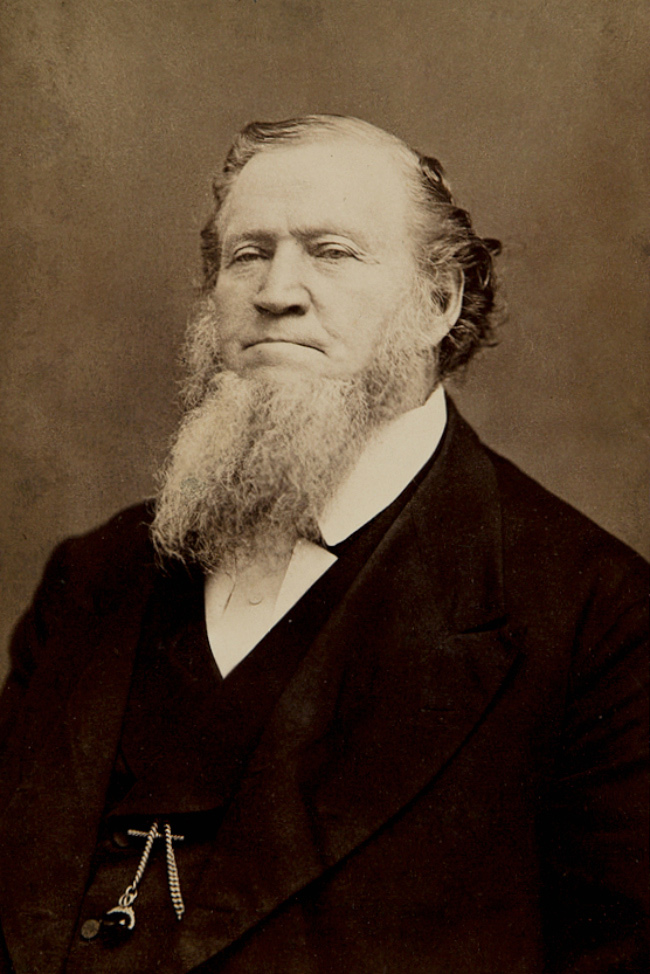
Conclusion: Prophets Are Not Infallible, But The Gospel Is
As I have said before, nearly all of these controversial statements made by Brigham Young come from the Journal of Discourses, which is an unreliable source. But is it possible that Brigham may have said some of these things and preached them? It most certainly is possible, but we must always remember that the prophets are human and make mistakes that should not shake our faith in the gospel.
Because they are human, the prophets are not infallible. However, the gospel of Christ is infallible and will always be a sure foundation. God would not have allowed statements of this nature to be preached as accepted doctrine of the Church, and they weren’t. Just because the prophets have faults does not disprove the gospel.
For those who feel the weaknesses of our prophets and apostles prove that our church is not true, may I point out that modern-day prophets weren’t the only ones to make mistakes. The chart below from Fair Mormon article “Do Latter-day Saints believe that prophets are infallible?” shows that biblical prophets also made mistakes.
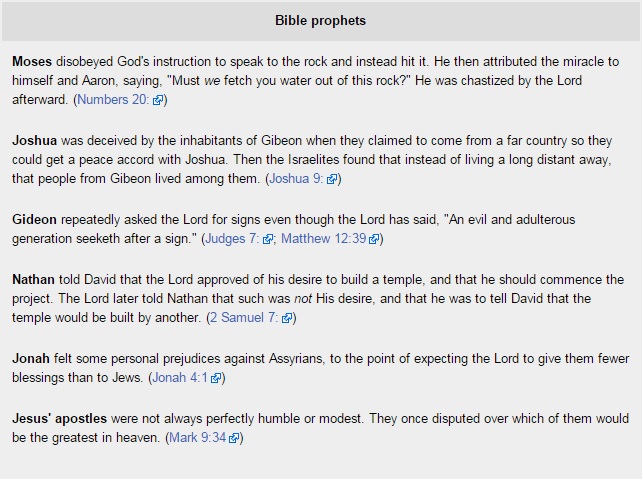
Biblical prophets also weren’t the only ones to err. Moroni speaks of the imperfections of himself and other prophets in Mormon 9:31. He also advises:
Condemn me not because of mine imperfection, neither my father, because of his imperfection, neither them who have written before him; but rather give thanks unto God that he hath made manifest unto you our imperfections, that ye may learn to be more wise than we have been.
Those who feel confused about the mistakes and obscure, controversial statements by the past prophets must remember that the truth and doctrine of our church is sustained by all fifteen of the prophets and apostles, is preached often, and can be found in the standard works. Anything that seems contrary to our doctrine and was taught in the past is just that, the past. We must “press forward” as 2 Nephi 31:20 teaches and look forth to our modern-day prophets, relying on the spirit of revelation to guide us down the right path.


